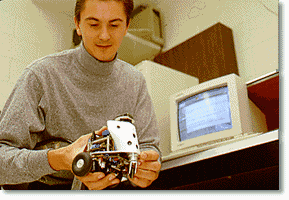
Robot Teachers: Internet is cyberclassroom
By ELLEN GOLDBAUM
News Services Editor
Talk about distance learning!
The University at Buffalo on Friday was the site of one-half of the
world's first cyber-experiment in which robots on different continents
communicated over the Internet. The other half took place around the world
at the University of Reading in England.
The experiment was judged a success as two members of a troupe of
three-wheeled, six-inch-by-six inch robots resembling a child's
remote-control toy auto and dubbed the "Seven Dwarfs" by their creators
took turns teaching each other a lesson about movement.
"Happy" at UB and "Bashful" in England took turns being mentor and
student, demonstrating to the experiment's human designers that robots can
use the Internet to teach each other new skills.
The experiment was sponsored by the UB Department of Electrical and
Computer Engineering, which provided the computing platform, and a group
led by Kevin Warwick, professor in the Department of Cybernetics at the
University of Reading, which created the two robots and the
artificial-intelligence programs.
UB Professor Mohammed Safiuddin said the experiment's success shows
that scientists "can begin to design intelligent machines that could
'debug' themselves when problems arise, based on instructions received
through Internet link-ups like this one."
The fact that the robots were able to communicate via the Internet proved
some important basic principles. "The object of the demonstration was to
show that robots can exhibit some intelligence," added Safiuddin, advanced
technology applications professor in the UB Department of Electrical and
Computer Engineering and an expert in industrial automation.
Each robot participating in the experiment has its own small brain and
the ability to learn from and communicate with other "dwarfs."
Endowed, or programmed, with only two basic instincts, "Happy" and
"Bashful" demonstrated that they can build on those instincts and learn
from their environments.
 "The rules or instincts we gave the robots were simply that one, it's
good to go forward, and two, it's good to move away from objects,"
explained Iain Goodhew, doctoral candidate from the University of
Reading,
who was in Buffalo for the demonstration.
"The rules or instincts we gave the robots were simply that one, it's
good to go forward, and two, it's good to move away from objects,"
explained Iain Goodhew, doctoral candidate from the University of
Reading,
who was in Buffalo for the demonstration.
Once switched on, the robots required no remote control or human
intervention.
The goal of the experiment was to get one robot to instruct its
transcontinental counterpart on how to move gracefully around a cubicle.
The two would then switch roles and the robot that had learned the lesson
would teach it to the other robot. (All of the learning that one robot
gained from the other, is immediately erased when the robot is switched
off. )
The two communicated via radio-frequency signals sent to personal
computers in their respective university laboratories that then were
transmitted via the Internet.
During the portion of the experiment in which "Happy" assumed the role
of student, the robot at UB stood still while it accumulated information
being sent from "Bashful" via the Internet. A few moments later, it began
moving erratically. Soon, it was gliding across the floor confidently,
successfully steering clear of the cardboard retaining wall that had been
erected around it.
Four ultrasonic sensors enable the robots to detect how far they are
from nearby objects in the same way that ultrasound helps a bat avoid
obstacles.
At one point, the experiment took an unexpected turn as either the
slippery floor, or possibly a buildup of dust on its wheels, had "Happy"
bumping into the retaining wall.
But this proved a learning opportunity because moments later the robot
slowed down, demonstrating its ability to take what it had just learned and
adapt to its environment.
"It's like when a baby is learning to walk and it keeps bumping into
things," explained Safiuddin. "After a couple of tries, the baby knows not
to bump into them. It has learned from its environment. In much the same
way, these robots are demonstrating a very simple form of intelligence."
He added that with today's increasingly global economy and the spread
of production plants throughout the world, the time has come for robots
that can perform tasks intelligently in industrial settings.
"Our demonstration shows that we do not need any extraordinary hardware
or software in order to conduct communications between robots in different
locations, even in different countries," Safiuddin explained.
"We can tap into the existing infrastructure of the information
superhighway."
PHOTO BY FRANK CESARIO
![[Current
Issue]](http://www.buffalo.edu/reporter/icons/Goto_Current.gif)
![[ Table
of Contents ]](http://www.buffalo.edu/reporter/icons/TOC.gif)
![[ Search
Reporter ]](
http://www.buffalo.edu/reporter/icons/Newspaper.gif)
![[Talk to Reporter]](
http://www.buffalo.edu/reporter/icons/Phone.gif)
 "The rules or instincts we gave the robots were simply that one, it's
good to go forward, and two, it's good to move away from objects,"
explained Iain Goodhew, doctoral candidate from the University of
Reading,
who was in Buffalo for the demonstration.
"The rules or instincts we gave the robots were simply that one, it's
good to go forward, and two, it's good to move away from objects,"
explained Iain Goodhew, doctoral candidate from the University of
Reading,
who was in Buffalo for the demonstration. 